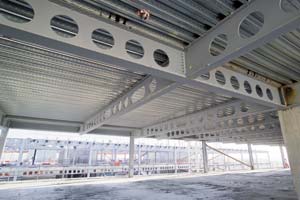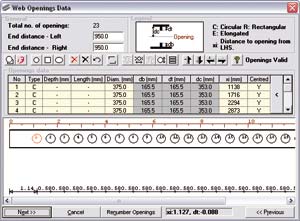Quad Core processors are shipping and brand new workstations from CAD 2 and HP offer much for high-end users. However, Dual Core still has a huge role to play in the CAD sector and Scan puts forward an excellent value propostion for mid range CAD users, says Greg Corke.
I recently heard a great analogy for Quad Core CPU technology from a Canadian analyst at HP and IntelÝs Quad Fest event in Colorado. He likened CPU cores to disposable razors, which have added more and more blades over the years. Do two, three or four blades shave you any closer than one? Probably not, but the guys that make the razors would certainly have you believe it – David BeckhamÝs chin certainly looked smooth on the telly!
Now IÝm not saying Quad Core is all about good marketing without substance – far from it. The technology clearly provides a perfect platform to help transform the way architects and engineers work with CAD, rendering and analysis software. However, Quad Core certainly means different things to different people.
Two CPU cores in a single workstation will be more than sufficient for many users, particularly if all they do is design. Four cores are great if you run CAD with structural analysis number crunching in the background, and eight cores are already becoming a necessity if youÝre a design visualisation user looking to slash your rendering times. ItÝs all about finding the right tool for the job, which is why this month we bring you three brand new workstations which range from two to a whopping eight cores, and vary in price from a staggering ú6,000 right down to just under a grand!
CAD2 Imagine QX64
CAD2 Imagine QX64
- Intel Core2 Extreme QX6700 (2.66GHz) (quad core)
- 4 x 1GB PC2-6400 800MHz memory
- ASUS P5WDG2 motherboard (Intel 975X chipset)
- PNY Quadro FX 1500 graphics card (256MB)
- 2 x 150GB Western Digital Raptor drives (OS + Apps)
- 1 x 320GB Seagate Barracuda 7200.10 S-ATA300 (data)
- 8-in-1 Digital Memory Card Reader?
- 18x Dual Layer Dual Format +/- DVD-ReWriter
- Microsoft Windows XP (32-bit or 64-bit) (with free Microsoft Vista Upgrade)
- ú2,145
The Intel core2 extreme QX6700 processor at the heart of CAD2Ýs latest workstation isnÝt actually a native Quad Core processor; itÝs two 2.66GHz Core 2 Duo E7000 chips bolted together, each of which shares 4MB of Level 2 cache, giving 8MB in total. The end result is a chip that boasts excellent performance in multithreaded applications and impressive capacity for multi tasking, but,when all four cores are being hammered, outputs a fair amount of heat. As a result, those who have been spoilt by the near silent operation of most recent Intel Dual Core-based workstations may be a little disappointed when the CAD Imagine QX64Ýs cooling fans kick into overdrive. ItÝs not loud by any stretch of the imagination, but noticeable all the same.
This is a small price to pay for cutting edge performance which the Imagine QX64 has in abundance, making incredibly light work of scan line rendering in 3ds Max 9 and hardly raising an eyebrow when running concurrent calculations in multiple applications. A total of 4GB of RAM makes this level of multi tasking possible, but for those working with much larger datasets, the machine can be equipped with a maximum of 8GB (4 x 2GB DIMMS) and of course Windows XP x64 Edition to unleash this additional capacity. (N.B. Both 32-bit and 64-bit versions of Windows XP Professional come with a free Microsoft Windows Vista upgrade pack)
The graphics card is the mid-range PNY Quadro FX 1500, which delivers excellent performance under most CAD applications. Those that are used to working with OpenGL in 3ds Max may be disappointed to learn that NvidiaÝs dedicated Quadro Maxtreme 9 driver has now been optimised for Direct3D instead of OpenGL. As a result, OpenGL performance has taken a hit, which is sure to affect those who prefer to work in wireframe, an area where previous generation OpenGL Maxtreme drivers were strong. On the flip side, this is likely to add stability to DirectX, which is certainly the future of 3ds Max, though performance does not seem to have improved much over standard DirectX drivers.
The Imagine QX64 is laden with storage options, which include an 8-in-1 Digital Memory Card Reader and 18x Dual Layer Dual Format +/- DVD-ReWriter. This is in addition to its two 150GB Western Digital Raptors, which are configured in a Level 0 Raid Array as a single high performance OS/application drive, and a massive 320GB Seagate Barracuda 7200.10 S-ATA300 drive which is optimised for data storage.
The Black/Silver ATX Workstation chassis is solid and once the lid is off you can see the components are neatly wired throughout. ThereÝs still room for expansion in terms of additional hard drives and supplementary cards, however, with only a single CPU socket and capacity for four DIMMs, the ASUS P5WDG2 motherboard is already full to capacity – so if youÝre looking for a machine to grow into there are limited options here. In saying this though, a careful choice of memory at the outset and the fact that youÝve already got four extremely powerful processor cores at your disposal should ensure this workstation will serve your compute intensive requirements now and well into the future. This is with particular reference to growing datasets and 64-bit operating systems.
The Imagine QX64 is certainly an attractive proposition for those who carry out multiple computational tasks at once, or work with multithreaded rendering applications such as 3ds Max. Whether your average CAD user will ever make use of all four cores is another question entirely and here a 2.66GHz Dual Core E6700, which drops into the same Intel LGA 775 slot, would be the better and more cost effective choice.
HP xw8400
HP xw8400
- 2 x Intel Xeon E520 (1.86GHz) (quad core)
- 2 x 2GB DDR-2 PC2-5300 667MHz memory
- HP motherboard (Intel 5000X chipset)
- Nvidia Quadro FX 5500 graphics card (1GB)
- 250GB Seagate Barracuda 7200.9 hard drive
- DVD+/-RW Double Layer LightScribe
- Microsoft Windows XP (32-bit or 64-bit)
- ú6,021
For a machine kitted out with two Quad Core processors, youÝd expect something pretty special when it comes to performance. However, with IntelÝs roll out of Quad Core Xeons staggered in two phases, those that board the bus too soon are likely to be rather underwhelmed. At the time of writing, the fastest processor HP can deliver inside its high end xw8400 is the Xeon E520, which runs at a modest 1.86GHz. However, the faster E5335 (2.0GHz), E5345 (2.33GHz) and X5355 (2.66GHz) chips should be available by the time you read this.
While having eight cores in a workstation promises huge capacity for parallel processing, the problem that all CAD users have is that too many processes, including graphics, currently rely on the performance of a single core. And when this goes down to a relatively low 1.86MHz you start to notice the current shortfalls in IntelÝs Xeon Quad Core technology.
Out of all the machines on test this month – including ScanÝs sub ú1,000 3XS workstation ± HPÝs xw8400 was the slowest machine when it came to 3D graphics, despite sporting a top of the range Nvidia FX5500 graphics card. It also brought up the rear in most of our CPU intensive CAD application tests. Indeed, you only really start to see the true potential of eight cores when rendering in 3ds Max 9, but despite setting a record in this multithreaded application, there wasnÝt a huge performance gain over CAD2Ýs Intel Core2 Extreme QX6700, 2.66GHz-based machine, which has four cores.
However, to disregard the xw8400 on its current processor performance would be a huge mistake. This high-end workstation benefits from HPÝs increasingly impressive industrial design, both in terms of build quality and accessibility. From hard drives to memory, all components are easy to get to, and with only 2 x 2GB DIMMs filling eight of its memory slots, the machine can be easily upgraded to a substantial 16GB, which will be invaluable for many high-end design visualization users. In addition, despite featuring a combined thermal design power (TDP) of 160W, the machine still ran relatively quietly with all eight cores in full flow. It will certainly be interesting to see how the xw8400Ýs optimised cooling system reacts when loaded with two 120W TDP Xeon X5355 (2.66GHz) chips.
And itÝs with this processor and IntelÝs E5345 (2.33GHz) that the xw8400 will start to come into its own, providing plenty of power to drive the high-end CAD applications of today and tomorrow, whilst also unleashing the true power of NvidiaÝs ultra high-end Quadro FX5500 in graphics intensive operations. We would expect that by the time you read this the xw8400 will be starting to benefit from IntelÝs second quad core phase, but expect to pay a huge premium for the pleasure. Cutting edge technology such as this doesnÝt come cheap.
Scan 3XS
Scan 3XS
- Intel Core 2 Duo E6600 (2.4 GHz) (dual core)
- 2 x 1GB Corsair DDR-2 PC2-6400 800MHz memory
- ASUS P5B-E iP965 S775 motherboard
- ATI FireGL V3400 graphics card (128MB)
- 250GB Samsung SpinPoint P120 hard drive
- NEC 18x DVD?RW Dual Layer
- Microsoft Windows XP (32-bit or 64-bit) (with free Microsoft Vista upgrade)
- ú960
It was only in mid summer 2006 that Intel introduced its new generation dual core chip, the Core2 Duo, and by the New Year there are already some serious bargains to be had as Quad Core comes into view. IntelÝs Dual Core 2.4GHz Core 2 Duo E6600 is now available for well under ú200 and if youÝre not heavily into analysis or design visualisation, itÝs one of the best price/performance chips currently out there. This fact has not been lost on Bolton-based workstation manufacturer, Scan, who has put the E6600 at the heart of its new 3XS workstation to deliver a machine that not only boasts an extremely attractive price point, but is not exactly shy when it comes to performance.
Scan has partnered IntelÝs Dual Core chip with 2GB of DDR-2 memory, which is a minimum for most serious CAD users, but still provides capacity to work with some fairly large models. However, with two DIMMS free on the ASUS P5B-E iP965 S775 motherboard, this can always be expanded in the future. Four SATA slots also give plenty of options for additional hard drives and RAID configurations for increased performance and redundancy, though in terms of capacity the 250GB Samsung SpinPoint drive already does a good job.
The ATI FireGL V3400 graphics card, while being an entry-level card on paper, still gives a good account of itself under most 3D CAD applications we tested it with. However, 3ds Max users will probably need to make the upgrade to a FireGL V7300 or V7350, not only for enhanced geometry performance, but also to benefit from the additional memory. The 128MB of memory built into the FireGL V3400, doesnÝt go very far these days.
Just 12 months ago a dual processor workstation was considered a bit of a luxury, but now itÝs the de facto standard, even in an entry level machine like this. At the moment you pay a premium for Quad Core and you have to ask yourself if you really will make use of this new generation technology. If youÝre a typical CAD user, I would suggest the answer is no and machines like ScanÝs 3XS workstation offer an excellent proposition for architects and engineers, and more importantly for those that pay the bills, as it does this for under ú1,000.








